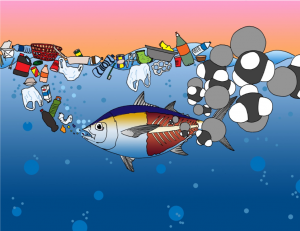by Nathaniel Holloway, Environmental technician
Plastic has become central to the way humans package, ship, and consume products. This includes everything from electronics, to medications, to baby toys. Plastic was—and still is in some contexts—considered a miracle product which is waterproof, hard-wearing, and easily malleable. However, we have allowed this material with a myriad of unknown adverse health effects to accumulate in Earth’s oceans. While it may seem like an “out of sight, out of mind” scenario, it most certainly is not.
Plastic in the open ocean does not stay in its original size or shape; it is rendered frail due to photo-degredation by the sun’s rays and is subsequently fractured into smaller and smaller pieces by the constant battering of waves. These tiny bits of plastic are ingested by all surrounding animals. Many of the predators—humans included—then eat the fish that have themselves accumulated plastic and the harmful chemicals found within. The plastics do not disappear — they accumulate. As such, our collective neglect for the natural habitats of wildlife has a direct impact on our own health and wellbeing. Furthermore, poisoning animals in an ocean reduces the biodiversity of an area and can cause a ripple-effect which collapses the food-chain, rendering an entire ecosystem—plants included—unstable.

Li, V. (2020). An Unexpected Dinner Guest: Marine Plastic Pollution Hides a Neurological Toxin in Our Food. The New York Times.
As pervasive as plastics have become, they can be limited in part through personal choices. Shopping in a store which allows you to purchase bulk goods in your own containers can save countless bags from joining the already mounting piles of garbage in landfills and in the oceans. Utilizing reusable bags when shopping, choosing plastic-free alternatives, and shopping local all also reduce one’s plastic consumption. Another tactic to reduce plastic consumption is to rethink whether or not you truly need a new product—whether it is eyeing new clothing when you have unworn pieces at home, or buying a packaged granola bar when you could make one yourself at home.
Perfection is not essential to reduce waste. As I’ve heard said by zero waste chef Anne-Marie Bonneau, “We don’t need a handful of people doing zero waste perfectly. We need millions of people doing it imperfectly”. You should not try to cut all plastic from your consumption overnight as this may be stressful, draining, and discouraging. As the old saying goes, slow and steady wins the race, and this holds true for the zero-waste movement, too. You may try changing a few plastic-wrapped products you typically purchase to a glass, metal, paper or wood alternative. Every time you shop or eat out from that point on, you will be equipped with new plastic-free substitutes for your needs. This will eventually drastically lessen your personal single-use plastic consumption.
Creating waste can be a source of stress and can impact how we see ourselves when we aspire to completely stop our consumption of plastics. As such, it is important to understand that creating waste is a part of living and—by extension—being human. In fact, I will be the first to say that though I am no fan of plastic, I would be less inclined to trust medication which was not given to me in a sealed and sterilized plastic bottle, for example. The goal is to look for products which do not necessitate the use of plastic—such as clothing, tools and various food items—instead of obsessing over what necessitates plastic.
Here are some resources if you are interested in learning more about single-use plastics:
- Great Canadian Shoreline Cleanup: https://shorelinecleanup.ca/
- Plastic Oceans Canada: https://plasticoceans.ca/
- Oceana’s Plastic Pollution campaign: https://oceana.ca/en/our-campaigns/plastics/campaign
- Canadian Wildlife Federation’s plastics reduction petition: https://cwf-fcf.org/en/explore/do-more/petitions/plastic-petition.html

Excellent tips for all consumers. Thanks for your insightful blog,Nathaniel. Making a conscious effort to choose non-plastic options is the only way to go.